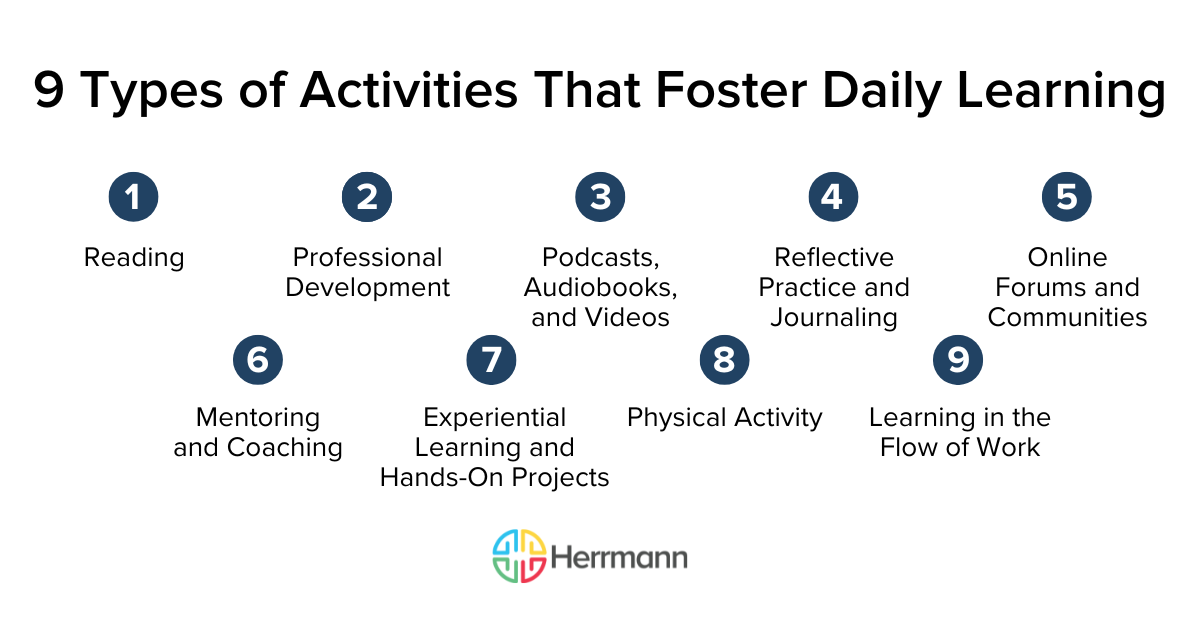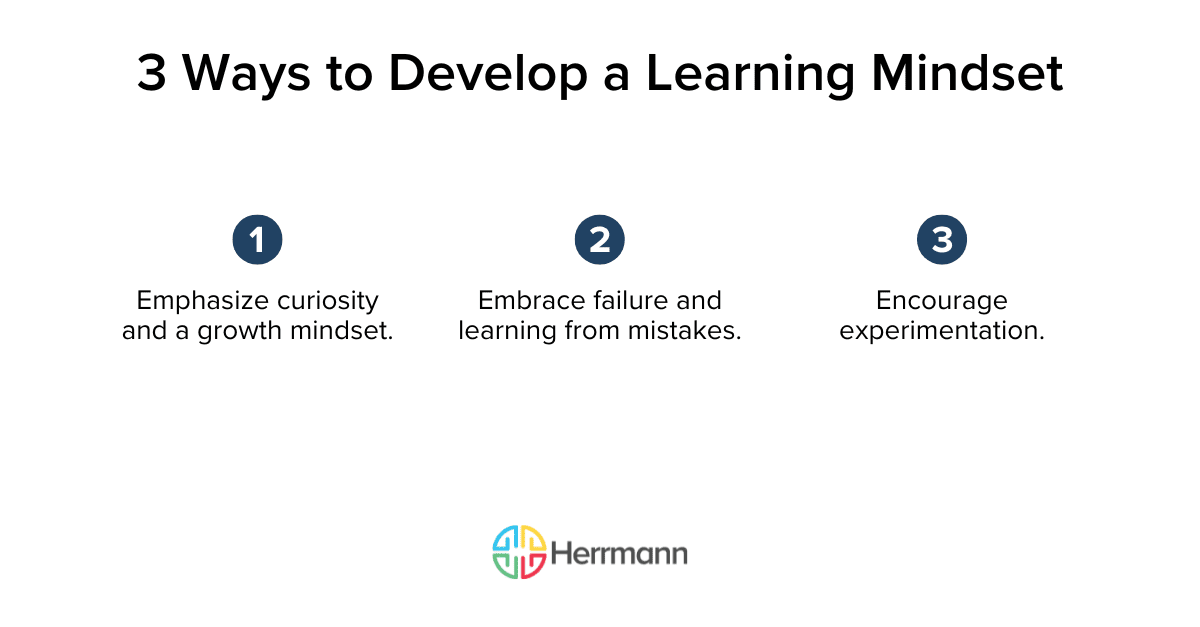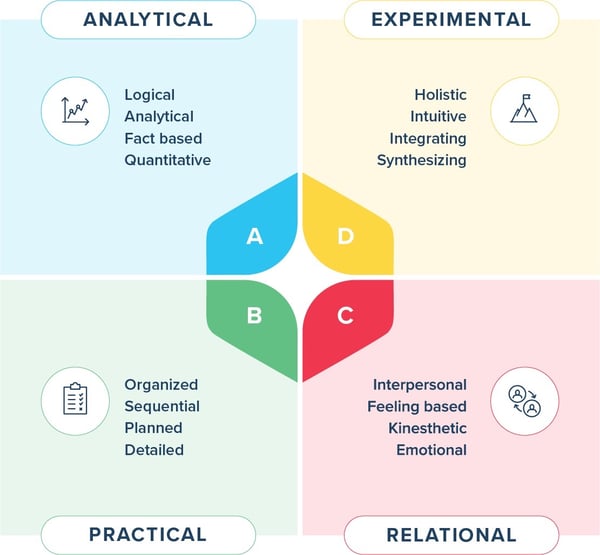At Herrmann, we talk about learning as a mental process that leads to lasting change in knowledge, behavior, or both. A key word to notice in that sentence is “process.” It’s not an outcome — it’s a series of actions. You need to learn something new every day to keep growing.
Learning isn’t just an add-on or an optional activity; it’s increasingly vital for individuals and the broader workforce. The World Economic Forum famously predicted in 2021 that 50% of jobs could require reskilling by 2025. Since then, the workplace has changed rapidly, with the introduction of generative artificial intelligence, the entrenchment of hybrid and remote work, and an ongoing tight labor market. To keep up, employees and employers must learn how to learn.
Learn more about the importance of learning each day, habits and activities to embrace, introducing a learning mindset to your team, and how Whole Brain® Thinking can foster your curiosity and pursuit of knowledge.
Why Daily Learning Matters for Leaders and Teams
While ensuring children go to school to learn, we don’t necessarily require — or foster — a learning mindset in working-age adults. But today’s economy requires us to embrace learning if we want to thrive as individuals and to attract and retain the best talent. Consider these statistics:
- 25% of job-related skill sets have changed since 2015 (LinkedIn).
- 64% of employees will find a new job if you don’t provide them with skills development (Cornerstone).
- 31% of employees ages 18 to 34 want opportunities to learn new skills when job searching (LinkedIn).
- Most employers provide insufficient opportunities for continuous learning (Boston Consulting Group).
Let’s look at some of the benefits of a learning-focused approach and examples of companies doing it right.
Benefits for People and Teams Who Learn New Things Daily
There are numerous advantages of daily learning for business leaders and their teams. Continuous learning helps leaders and collaborative teams think critically and creatively. They can analyze complex situations while considering multiple perspectives. They make better decisions by working through these situations in good faith and without judgment.
Because learning is encouraged, teams are more likely to enjoy psychological safety. This encourages innovation because teammates constantly have new experiences and are encouraged to bring these concepts — and the ideas they sparked — to the group.
Daily learning also increases adaptability in a rapidly changing business landscape. Because leaders and teams regularly add to their knowledge and skills, they embrace new technologies, processes, and market trends. They see opportunities in challenges like evolving customer needs or shifting industry best practices rather than focusing solely on the downsides.
Furthermore, daily learning boosts confidence and motivation among leaders and team members. Learning new skills and expanding knowledge instills a sense of accomplishment and empowers people to take on new challenges enthusiastically. Ongoing learning is a crucial component of self-directed leadership development.
Examples of Companies Succeeding With Continuous Learning
Google has long been famous for its 20% rule, in which employees can spend the equivalent of one workday each week focused on experimentation, problems, or learning that doesn’t provide immediate dividends to the business. The idea is that innovation is borne from this extra time rather than from the 80% of the workweek spent doing regular tasks.
Another company known for its learning culture is AT&T, which has embraced learning as part of a long-term reskilling movement. The company has an in-house university, supplemented by team-specific learning programs based on dozens of employee personas.
Meanwhile, at Yelp, “every day is a school day” for the learning and development (L&D) team, but with a personalized learning approach instead of a top-down mandate. As part of that mindset, departments take distinct approaches to learning. Yelp also helps employees learn by pairing workers and bringing in outside speakers, among other opportunities.
Sign up to our newsletter for the latest insights

9 Types of Activities That Foster Daily Learning
Learning comes in many forms, provided you have intention and curiosity. Whether it’s mind hacks, classroom learning, or indirect activities that open your mind to learning, here are some ways you can be a learner, not a knower.
Reading
Reading is the most straightforward way to foster daily learning. Whether it's books or articles, fiction or nonfiction, the news or something lighter, reading exposes us to new ideas, perspectives, and knowledge. Reading increases our vocabulary, expands our thinking, and stokes our curiosity about what we’ve just learned.
Professional Development
Professional development can be instructor-led or self-guided, in-person or online. Whatever the format, this is a focused way to pursue learning, usually related to your field or specialization.
For example, industry conferences and classroom learning can help us dive deep into specific topics guided by experts. Online courses and webinars, such as those on LinkedIn Learning, provide similar expertise and structure without needing to physically travel. On-demand versions of formal learning provide even more flexibility.
Regardless of the format, structured learning opportunities help us acquire new skills, deepen our knowledge, and stay current with our industries.
Podcasts, Audiobooks, and Videos
Listening to podcasts and audiobooks is a convenient way to incorporate learning into daily routines. Informative, educational audio is available on almost every subject imaginable. While you can benefit from audio while doing other things, such as commuting or working out, consider how audio can be a focused activity for deeper learning.
Video is increasingly becoming an option for this type of learning, including video-enabled podcasts, educational offerings such as TED Talks, and bite-sized microlearning videos.
Reflective Practice and Journaling
Taking time for self-reflection and journaling can be a powerful tool for daily learning. We learn more about ourselves by reflecting on our experiences, thoughts, and emotions. Journaling, mediation, and other reflective practices can help us eliminate distractions, reduce tension, work through challenges and insecurities, and make meaningful connections between new information and existing knowledge.
Online Discussion Forums and Communities
For people who want to trade ideas and perspectives with fellow travelers in their field of interest or industry, online forums, and communities can help you learn from peers and thought leaders while sharing your expertise.
Not all online communities are equal; ensure that you’re learning, not just spinning in trivial, combative, or toxic conversations.
Mentoring and Coaching
Mentors and coaches can help you explore the bigger picture of your career and life while providing valuable third-party perspectives. They also can help you explore some of the other learning habits mentioned here. Regular interactions with mentors or coaches create a structured learning environment and encourage goal-oriented continuous improvement.
Experiential Learning and Hands-On Projects
Engaging in hands-on projects and experiential learning activities allows people to apply their knowledge and skills in real-world scenarios. This type of learning fosters problem-solving abilities, critical thinking, and adaptability. There’s no substitute for hands-on learning to supplement formal instruction or training in many job roles.
Physical Activity
Engaging in regular physical activity has been shown to have positive effects on brain health and cognitive function. While this is an indirect way of learning, you can incorporate reading, audio, engaging conversations, and other activities into exercise to help you learn and unlock your creativity.
Learning in the Flow of Work
Learning in the workplace doesn’t have to be formal or separate from other tasks. Successful workplace cultures encourage employees to find learning in everything they do. Examples include observing and learning from colleagues, asking questions in meetings, and seeking feedback on your work. Organizations also can explore learning in the flow of work by creating dedicated channels for learning.

How to Develop the Mindset for Learning Something New
All of us can learn, but we might need help developing the right mindset and habits to make learning natural, enjoyable, and truly helpful. Here are a few steps to take when you’re trying to develop a learning mindset or help others do the same.
Emphasize Curiosity and a Growth Mindset
Psychologist Carol Dweck’s concept of a growth mindset is essential for developing learning habits. We must believe that we can grow through effort — that our intellect, personality, and capacity are not fixed. When we embrace a growth mindset, every day is an opportunity to learn, and we have immediate momentum to take the necessary actions.
Likewise, curiosity is a mindset we can develop. Psychologist Art Markman encourages us to start tactically — literally making lists of what we want to learn. Don’t prejudge your list. Write down anything you’re curious about without worrying about its importance, merit, or prioritization. Another way to be curious is to ask questions when encountering something new or when you come across something familiar. Move beyond your assumptions and see what else you can know.
By being curious and growth-minded, you’ll start to develop your learning muscles.
Embrace Failure and Learning From Mistakes
Failure is inevitable in the learning process and growth mindset. Most failures aren’t insurmountable. Even as you do your best, understand that you’ll fall short sometimes, and that’s when you can embrace growth and learning rather than beat yourself up over setbacks.
As a leader, discuss with your team the importance of resilience and perseverance in facing challenges. Encourage your people to reflect on their mistakes, identify lessons learned, and apply them going forward. By embracing failure and learning from mistakes, employees can improve their performance, productivity, and depth of knowledge without repeating the same mistakes.
Encourage Experimentation
Being in your comfort zone isn’t necessarily bad, but we can’t learn without stepping outside of it. Experimentation allows for exploration and discovery without committing to irreversible changes. Look for ways to experiment in your work, life, and daily habits. Encourage your team to do the same through something like 20% time or by creating room to test hypotheses and new business ideas.
By taking calculated risks, people can learn what works, what doesn’t, and how they might change their process the next time. They also become less afraid of failure and can distinguish between reasonable risks and recklessness. By creating the safety and structure to experiment, you’ll encourage a culture that celebrates and rewards new ideas without jeopardizing the business.

How to Create a Daily Learning Routine With Whole Brain® Thinking
The Whole Brain® Model is a useful framework for understanding how we think — and how we prefer to think, especially in the unfamiliar situations where learning occurs. Whole Brain® Thinking is based on the Herrmann Brain Dominance Instrument® (HBDI®) assessment, which measures four integrated systems of thinking preferences that help explain personal and professional success.
Those four integrated systems are expressed in the Whole Brain® Model as color-coded quadrants — analytical (Blue), practical/structural (Green), relational (Red), and innovative/experimental (Yellow) thinking. These quadrants are commonly referred to by their colors.
While each of us has a stronger preference for one or two quadrants, we can and do access each daily. There is no combination of quadrants that’s better or worse than others.
Think about how you might develop a daily learning habit:
- You set measurable goals to show you’re learning. That’s analytical, fact-based, and quantitative (Blue) thinking.
- You create a plan and schedule. That’s practical, organized, sequential (Green) thinking.
- You’re motivated to learn, whether for personal growth, to reach a goal, or to impress someone. That’s emotional and feeling-based (Red) thinking.
- You’re open to new concepts and experiences. That’s experimental (Yellow) thinking.
Here are some ways to develop a habit of learning something new every day — and how Whole Brain® Thinking can help you approach this from various perspectives.
Dedicate Time for Learning Each Day
As the saying goes, “What gets scheduled gets done.” Create a digital calendar entry, tackle learning first thing in the morning, or make other plans to ensure you don’t forget or get distracted. By scheduling learning time, you make a commitment to yourself, which can be motivating on those days when you don’t feel in the mood.
For practical thinkers, scheduling time is second nature. If you don’t gravitate toward the Green quadrant, this can be a chance to stretch your thinking. Relational thinkers, for example, might seek an accountability partner to foster a sense of responsibility and make learning more fun.
Create a Personalized Learning Plan With Goals
Every learning plan needs goals, but everybody’s learning goals will likely be different. Goal-setting is an analytical activity, especially if you create metrics to measure progress or report on the success of your learning initiative.
Personalized goals can be effective in helping people identify areas of improvement that align with their interests (Red). At a team or organizational level, goals can be personalized by job role or department, creating structure (Green) while allowing employees some freedom to explore and experiment (Red and Yellow).
Build Learning Activities Into Daily Habits and Routines
Integrating learning activities into daily habits and routines ensures that learning becomes a natural part of everyday life. Eventually, you might not need to schedule learning because you’ll have built the habit.
How you build learning into your daily routine can reflect your Whole Brain® Thinking preferences — and be an opportunity to stretch yourself. For example, if you regularly scour industry reports and data to learn the latest trends (Blue), you can continue that learning method. However, consider whether you’re missing learning opportunities through hands-on kinesthetic activities or collaborating with colleagues (Red).
Use Technology to Make Learning Easier
Reading, attending classes and lectures, and coaching are tried-and-true ways to learn that don’t necessarily require cutting-edge technology. Still, look at ways technology can make your path easier and help your organization keep track of your team’s learning habits.
Learning management systems are just one example of tech that can organize employee learning activities (Green), track progress (Blue), and encourage conversations and feedback (Red). Tech itself can be a learning opportunity as you and your employees see where else it can be applied (Yellow).
Build a Habit of Learning Every Day
Future leaders must be learners who help their teams embrace a growth mindset and become curious about what they don’t know. Fortunately, there are many ways to learn something new every day, and for most teams, it’s simply a matter of taking the time and exploring what techniques work best.
As you exercise your learning muscles, consider how Whole Brain® Thinking can help you and your teams better understand how you think — and how you can stretch your thinking to learn more, faster.
Want to keep learning and help your teams learn, too? Explore our manager’s guide to Whole Brain® Thinking.


.png)









